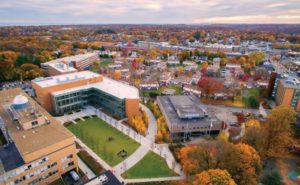
When Elycea Almodovar was searching for a college three years ago, she had just two criteria: It had to be diverse, and it had to have a record of actually graduating students like her.
Salem State, the most diverse public university in her home state of Massachusetts, checked both boxes. Its student body was 8 percent Latino and growing, and the graduation gap between its Caucasian and Latino students had narrowed at the time to less than two percentage points, well below the national average of 10 percentage points.
The school was doing so much better than its peers that it was named a top 10 institution for Latino student success by the Education Trust, which advocates for low-income and racial minority college-going. Almodovar, the daughter of Puerto Rican immigrants, was sold. She enrolled in the fall of 2015, and immediately felt at home, she recalled.
As the Latino population in the United States continues to grow, so has the number of young Latinos pursuing higher education. Between 2000 and 2015, the college-going rate among Latino high school graduates grew from 22 to 37 percent according to the U.S. Department of Education. This growth has compelled colleges including Salem State, whose student body went from 5 to 14 percent Latino over the past decade, to pay more attention to lingering achievement gaps between their white and Latino students.
To some extent, those efforts appear to be working. More than half of Latino students — 54 percent — now finish a bachelor’s degree within six years, up from 46 percent in 2002, the Education Department says. While more Latinos are going to college, and their graduation rates are rising, the progress remains uneven. Nationwide, the number of Latinos who graduate within six years is still 10 percentage points lower than the proportion of whites.
Students not just in Salem, but nationwide still insist that having a more diverse faculty; people that look like them and bilingual resources as well as expanding cultural programming, is key.

Recent Comments